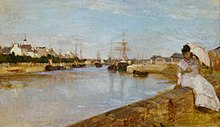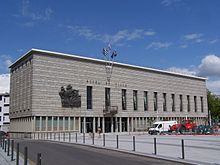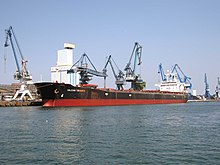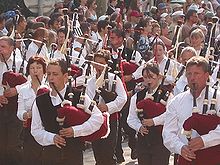Lorient
Lorient
An Oriant | |
|---|---|
Subprefecture and commune | |
 Aerial view of the harbour of Lorient | |
| Coordinates: 47°45′N 3°22′W / 47.75°N 3.36°W | |
| Country | France |
| Region | Brittany |
| Department | Morbihan |
| Arrondissement | Lorient |
| Canton | Lorient-1 and 2 |
| Intercommunality | Lorient Agglomération |
| Government | |
| • Mayor (2020–2026) | Fabrice Loher[1] |
| Area 1 | 17.48 km2 (6.75 sq mi) |
| Population (2021)[2] | 57,846 |
| • Density | 3,300/km2 (8,600/sq mi) |
| Time zone | UTC+01:00 (CET) |
| • Summer (DST) | UTC+02:00 (CEST) |
| INSEE/Postal code | 56121 /56100 |
| Elevation | 0–46 m (0–151 ft) |
| 1 French Land Register data, which excludes lakes, ponds, glaciers > 1 km2 (0.386 sq mi or 247 acres) and river estuaries. | |
Lorient (French: [lɔʁjɑ̃] ⓘ; Breton: An Oriant) is a town (commune) and seaport in the Morbihan department of Brittany in western France.
History
Prehistory and classical antiquity
Beginning around 3000 BC, settlements in the area of Lorient are attested by the presence of
Founding

In 1664,
The city's name is derived from Le Soleil d'Orient, the first ship constructed at the site, in 1669. Workers gave the site the name of the ship, which, by contraction, became simply L'Orient and finally Lorient.[6]
The
Growth under the Company of the Indies

The town experienced a period of growth when
Until the Company's closure, the city took advantage of its prosperity. In 1738, there were 14,000 inhabitants, or 20,000 considering the outlying villages of Kerentrech, Merville, La Perrière, Calvin, and Keryado, which are now neighbourhoods within the present-day city limits. In 1735, new streets were laid out and in 1738, it was granted city status. Further work was undertaken as the streets began to be paved, wharves and slipways were built along the Faouédic river, and thatched houses were replaced with stone buildings following 18th-century classical architecture style as it was the case for l'Enclos.[10] In 1744, the city walls were erected, and proved quickly useful as Lorient was raided in September 1746.[12] Following the demise of the Company, the city lost one-seventh of its population.[13]
In 1769, the city evolved into a full-scale
The
19th and early 20th centuries


Maritime activities slowed at the start of the 19th century. Activity at the shipyards and naval base reached a low that would last until the July Monarchy. During this period, the city was more of an administrative center.[15] The first secondary school opened in 1822, a lazaretto in 1823, and barracks in 1839.[16]
The city began to modernize in the second quarter of the century; in 1825, a roofed slipway and a
In the second half of the 19th century, the
In 1889, fishing expanded following the creation of the municipal fish market,
World War II
In 1941, the
In 1943–1944, Lorient was nearly razed to the ground by Allied
After the
Reconstruction

In April 1945, the Reconstruction Ministry advocated the use of temporary wooden shacks. These shelters were shipped as a kit to be built on site. In 1948, there were 28 settlements under the city's authority, and 20 more in the urban area, distributed among the neighboring towns of Ploemeur, Lanester, Hennebont and Quéven. Each of these neighbourhoods could hold up to 280 houses.
This temporary housing would stand from 10 to 40 years depending on the location. The last shack in the largest settlement, Soye, was torn down in 1991. Today, only a few buildings dating to the 18th century still stand.
Geography
Location

Lorient is located on the south coast of Brittany, where the rivers Scorff and Blavet join to form the roadstead of Lorient, before discharging into the Atlantic Ocean. The river Ter used to flow into the estuary to the south of the city, however, a dam was constructed in 1967, stopping the flow. The city is 503 kilometres (313 mi) south-west of Paris, 153 kilometres (95 mi) south-west of Rennes and 158 kilometres (98 mi) north-west of Nantes.
The city comprises different neighbourhoods:
|
|
|
|
Adjacent towns:
Climate
Under the Köppen climate classification, Lorient experiences an oceanic climate (Cfb), with mild winters and cool to warm summers. Precipitation is evenly distributed throughout the year. Frost is rare in winter, as are days over 30 °C (86 °F) during summer.
| Climate data for Lorient (Lann-Bihoué Airport) 1991–2020 normals, extremes 1952–present | |||||||||||||
|---|---|---|---|---|---|---|---|---|---|---|---|---|---|
| Month | Jan | Feb | Mar | Apr | May | Jun | Jul | Aug | Sep | Oct | Nov | Dec | Year |
| Record high °C (°F) | 16.8 (62.2) |
18.4 (65.1) |
23.3 (73.9) |
27.1 (80.8) |
29.8 (85.6) |
35.9 (96.6) |
37.6 (99.7) |
37.5 (99.5) |
31.0 (87.8) |
27.2 (81.0) |
19.6 (67.3) |
16.4 (61.5) |
37.6 (99.7) |
| Mean maximum °C (°F) | 13.5 (56.3) |
14.2 (57.6) |
17.5 (63.5) |
21.3 (70.3) |
25.3 (77.5) |
28.9 (84.0) |
29.7 (85.5) |
29.1 (84.4) |
26.5 (79.7) |
21.0 (69.8) |
17.0 (62.6) |
13.9 (57.0) |
31.4 (88.5) |
| Mean daily maximum °C (°F) | 9.7 (49.5) |
10.4 (50.7) |
12.6 (54.7) |
15.0 (59.0) |
18.1 (64.6) |
20.8 (69.4) |
22.5 (72.5) |
22.6 (72.7) |
20.7 (69.3) |
16.8 (62.2) |
13.0 (55.4) |
10.4 (50.7) |
16.1 (60.9) |
| Daily mean °C (°F) | 6.9 (44.4) |
7.1 (44.8) |
8.8 (47.8) |
10.7 (51.3) |
13.7 (56.7) |
16.4 (61.5) |
18.0 (64.4) |
18.1 (64.6) |
16.1 (61.0) |
13.3 (55.9) |
9.8 (49.6) |
7.5 (45.5) |
12.2 (54.0) |
| Mean daily minimum °C (°F) | 4.0 (39.2) |
3.8 (38.8) |
5.0 (41.0) |
6.4 (43.5) |
9.3 (48.7) |
11.9 (53.4) |
13.6 (56.5) |
13.5 (56.3) |
11.5 (52.7) |
9.7 (49.5) |
6.6 (43.9) |
4.6 (40.3) |
8.3 (47.0) |
| Mean minimum °C (°F) | −3.5 (25.7) |
−2.7 (27.1) |
−1.0 (30.2) |
0.4 (32.7) |
3.5 (38.3) |
6.3 (43.3) |
8.9 (48.0) |
8.0 (46.4) |
6.0 (42.8) |
2.8 (37.0) |
−0.1 (31.8) |
−2.6 (27.3) |
−4.9 (23.2) |
| Record low °C (°F) | −13.1 (8.4) |
−11.0 (12.2) |
−7.4 (18.7) |
−4.1 (24.6) |
−1.1 (30.0) |
1.6 (34.9) |
3.4 (38.1) |
4.1 (39.4) |
1.0 (33.8) |
−1.8 (28.8) |
−5.0 (23.0) |
−8.7 (16.3) |
−13.1 (8.4) |
| Average precipitation mm (inches) | 109.0 (4.29) |
82.5 (3.25) |
66.2 (2.61) |
67.5 (2.66) |
66.0 (2.60) |
52.0 (2.05) |
55.2 (2.17) |
53.3 (2.10) |
65.7 (2.59) |
103.8 (4.09) |
107.6 (4.24) |
114.5 (4.51) |
943.3 (37.16) |
| Average precipitation days (≥ 1 mm) | 14.3 | 11.6 | 10.9 | 10.6 | 9.8 | 8.0 | 8.3 | 7.7 | 8.3 | 12.6 | 13.8 | 14.2 | 130.1 |
| Average relative humidity (%)
|
88 | 85 | 82 | 79 | 81 | 80 | 80 | 81 | 84 | 87 | 87 | 88 | 83.5 |
| Mean monthly sunshine hours | 71 | 99 | 144 | 191 | 214 | 224 | 232 | 219 | 193 | 120 | 87 | 72 | 1,866 |
| Source: Météo France,[21] Infoclimat (humidity, 1961–1990),[22] and Meteociel [23] | |||||||||||||
Population
In 2017, Lorient had a population of 57,149.
The population data in the table and graph below refer to the commune of Lorient proper, in its geography at the given years. The commune of Lorient absorbed the former commune of Keryado in 1947.[26]
|
|
| |||||||||||||||||||||||||||||||||||||||||||||||||||||||||||||||||||||||||||||||||||||||||||||||||||||||||||||||||||||
| |||||||||||||||||||||||||||||||||||||||||||||||||||||||||||||||||||||||||||||||||||||||||||||||||||||||||||||||||||||||
| Source: EHESS[26] and INSEE[24] | |||||||||||||||||||||||||||||||||||||||||||||||||||||||||||||||||||||||||||||||||||||||||||||||||||||||||||||||||||||||
Breton language
The municipality launched a linguistic plan through Ya d'ar brezhoneg on 25 January 2007.
In 2008, 2.71% of the children attended the bilingual schools in primary education.[27]
Economy

Ports
Lorient is commonly referred to as La ville aux cinq ports ("the city of five ports"): military, fishing, commercial, passengers and yachting.[28] In 2010, the sector represented 9,600 direct jobs for a total 12,000 jobs (with indirect jobs accounted for), or 12% of local employment.[29]
- Keroman fishing port (fr): In 2010, with a catch of 27,000 tons, it was second only to Boulogne-sur-Mer regarding catch tonnage among French fishing ports, but first considering the cash value.[30] It accounts for 3,000 jobs (including 700 fishermen) and 130 fishing vessels.
- Kergroise cargo port : With 2.6 million tons of cargo per year (including oil, cattle fodder, sand, containers), it ranks first in Brittany.[31]
- Marinas : mooring berths are dispatched on Lorient (370), Kernevel (1,000), Port-Louis (450), Gâvres (57) and Guidel (102).[32] Additionally, there is an 800 metres (2,600 ft) long dock dedicated to offshore competitive sailing (Pôle course au large), recently built within the former submarine base.
- Passenger ships : each year, more 457,500 passengers set sail to the nearby islands of Belle-Île-en-Mer.
- Military : though no longer a wharves along the Scorffriver.

Industry
From its founding,
Transport
Lorient South Brittany Airport is situated just west of the city at Lann Bihoue, and it has direct flights to Paris. There are also direct flights to London and Porto in the Summer.
The
Education
Schools in Lorient belong to the Academy of Rennes.
Tertiary
- lycées.
- Université de Bretagne Sud.[33]
- Institut universitaire de technologie de Lorient
- École nationale supérieure d'ingénieurs de Bretagne Sud[34]
- École supérieure d'art.[35]
- École nationale de musique et de danse.[36]
Military
Active units based near Lorient:
- French armed forces, equivalent in their mission and affiliation to Navy SEALs or British Special Boat Service. Five out of the six existing naval commandos[37] are based in Lanester, just across the Scorffriver from Lorient. The Naval Fusilier & Commando Training School is also based here.
- airborne early warning, maritime patrol and air-sea rescue.
Lorient Submarine Base

Lorient was the location of an extensive
Culture

Events
Each year in August since 1970, Lorient hosts the Festival interceltique, bringing together artists from all the Celtic world (Brittany, Cornwall, Scotland, Ireland, Wales, Galicia, Asturias, Australia, Acadia and Isle of Man). Each year, a Celtic nation is chosen as honored guest. It is one of the biggest festivals in Europe by attendance (800,000 people for the 40th edition[38])
Media
Lorient is home to TébéSud (formerly TyTélé), a local TV channel covering Morbihan through DTT.
Religion
Catholic churches are among the main religious landmarks of Lorient. While the Church of Our Lady of the Assumption was built in 1850 in a revivalist neo-Gothic style, the church of Saint Joan of Arc was built in a neo-Roman style in the 1930s by French architect Jean Desbois and a few years later in 1955, and the modernist church of Notre-Dame-de-Victoire is the highest point of Lorient with its 4-meter-high concrete bell tower though the population never really accepted this new style.[39] Major Catholic festivals such as Christmas, Carnaval, Easter and the Pardon are celebrated as major feasts of the city.
Sports
Football
The most popular club in Lorient is FC Lorient, which currently play in Ligue 1, after winning Ligue 2 in 2020. They are nicknamed les Merlus. They play their home fixtures at Stade du Moustoir. Christian Gourcuff has managed the team for over 20 years (aggregate years).
Sailing
The converted submarine base has been home port to several skippers and their sailing teams:
- Jérémie Beyou[40] (Delta Dore),
- Pascal Bidégorry[40] (Banque Populaire),
- 2011–12 Volvo Ocean Race
- Samantha Davies[40] (Roxy),
- Jean-Baptiste Dejeanty[40] (Maisonneuve),
- Jean-Pierre Dick[40] (Paprec-Virbac),
- Yann Elies[40] (Generali),
- Alain Gautier[40] (Foncia),
- Sébastien Josse[40] (British Telecom),
- Marc Thiercelin[40] (DCNS)
Lorient was also a staging port during the
Notable Lorientais
Arts and literature
- Marie-Léontine Bordes-Pène (1858–1924), pianist
- Charles Delioux (1825–1915), composer and pianist
- Marie Dorval (1798–1849), actress
- Irène Frain (b. 1950), writer
- Ernest Hello (1828-1885), writer
- Viktor Lazlo (b. 1960), singer
- Rita Strohl (1865–1941), pianist and composer
- Jacques Vaché (1895–1919), writer and artist
Sailors
- Jean-Baptiste Bompard (1757–1842), took part in the American Revolutionary War as a privateer, later rose to the rank of admiral.
- maritime prefect
- Jean-Baptiste Chaigneau (1769–1832), sailor, French consul in Cochinchina
- Pierre-François Forissier, b. 1951, admiral, Chief of Staff of the French Navy (2008–2011)
- Kerguelen islands.
Politics
- naval architect, chief designer of the Napoléon, La Gloire and Gymnote, which were breakthroughs in naval technology, also designed airships, deputy representing Morbihan, member of the Academy of Sciences, senator for life.
- Pierre-Paul Guieysse (1841–1914), Morbihan deputy, Minister of the Colonies.
- Minister of Defence
- Académie française.
Sports
- Georges Eo, b. 1948, former football player and manager
- Christian Gourcuff, b. 1955, former manager of FC Lorient
- international midfielder, currently plays for Stade Rennais F.C.
- Ronan Le Crom, b. 1974, goalkeeper
- Jérémy Morel, b. 1984, left-back for Olympique de Marseille
- Illan Meslier, b. 2000, goalkeeper for Leeds United
Sciences
- Pierre Fatou (1878–1929), mathematician and astronomer
- Nicole Le Douarin, b. 1930, biologist
Others
- Compagnon de la Libération.
- Élisabeth Le Port (1919-1943) WWII French Resistance member.
- Jacques Stosskopf (1898–1944), naval engineer, résistant. Mistaken for being a traitor, in 1946 the submarine base was renamed "Base Ingénieur Général Stosskopf" in his honour.
International relations
Lorient is
 Galway, Ireland
Galway, Ireland Vigo, Spain
Vigo, Spain Wirral, England, United Kingdom
Wirral, England, United Kingdom Ventspils, Latvia
Ventspils, Latvia Ludwigshafen, Germany
Ludwigshafen, Germany České Budějovice, Czech Republic
České Budějovice, Czech Republic Denizli, Turkey
Denizli, Turkey
See also
- Mississippi Company
- FC Lorient
- Festival Interceltique de Lorient
- Arrondissement of Lorient
- Communes of the Morbihan department
- Raid on Lorient (1746)
- History of Lorient
- Gabriel Hotel
References
- Notes
- ^ "Maires du Morbihan" (PDF). Préfecture du Morbihan. 7 July 2020.
- ^ "Populations légales 2021". The National Institute of Statistics and Economic Studies. 28 December 2023.
- .
- .
- ^ .
- ^ "L'Origine du nom de Lorient". 11 September 2012.
- .
- ^ .
- ^ René Estienne, « Les archives des compagnies commerciales et la traite : l'exemple de la Compagnie des Indes », Service historique de la Défense, Lorient, janvier 2009
- ^ .
- ^ .
- .
- ^ .
- .
- ^ .
- ^ .
- ^ .
- ^ .
- ^ Lagarrigue, Max (2007). "Comment les Français vivent-ils les bombardements alliés?". Arkheia. Archived from the original on 3 July 2013. Retrieved 21 March 2013.
- ^ Hans, Goebeler (2008). Steel Boats, Iron Hearts. Savas Beatie LLC.
- ^ "Données climatiques de la station de Lorient" (PDF) (in French). Météo France. Archived (PDF) from the original on 9 July 2021. Retrieved 9 September 2023.
- ^ "Normes et records 1961-1990: Lorient-Lann Bihoué (56) - altitude 42m" (in French). Infoclimat. Retrieved 30 December 2015.
- ^ "Normales et records pour Lorient-Lann Bihoue (56)". Meteociel. Retrieved 14 September 2020.
- ^ a b Population en historique depuis 1968, INSEE
- ^ "Comparateur de territoire, Intercommunalité-Métropole de CA Lorient Agglomération (200042174)". INSEE. Retrieved 2 September 2020.
- ^ a b Des villages de Cassini aux communes d'aujourd'hui: Commune data sheet Lorient, EHESS (in French).
- ^ (in French) Ofis ar Brezhoneg: Enseignement bilingue
- ^ "Lorient-ports". Archived from the original on 9 October 2013. Retrieved 11 March 2013.
- ^ Josse, Charles (25 March 2011). "Lorient : Actualités et infos en direct, sorties, agenda, images, 56100 - Ouest-France". Ouest-France. Retrieved 11 March 2013.
- ^ "26 000 tonnes de poisson au port de pêche de Lorient". Ouest-France. 7 January 2011. Retrieved 11 March 2013.
- ^ "Lorient - Ports". Archived from the original on 11 January 2012. Retrieved 11 March 2013.
- ^ "Ports - Pays de Lorient". Retrieved 11 March 2013.
- ^ "Tout savoir sur la vie des campus". www.univ-ubs.fr. 6 April 2023.
- ^ "Accueil du site de l'ENSIBS - Université Bretagne Sud". www-ensibs.univ-ubs.fr. 3 May 2021.
- ^ "École Supérieure d'Art". Archived from the original on 4 March 2013. Retrieved 27 March 2013.
- ^ École Nationale de Musique et de Danse Archived 12 March 2009 at the Wayback Machine
- ^ In the French Navy nomenclature, commandos are understood as units, not individuals
- ^ "Record d'affluence au Festival interceltique de Lorient". Le Monde. 16 August 2010. Retrieved 25 March 2013.
- ISBN 978-2-900791-77-6.
- ^ a b c d e f g h i j "Voile news". Retrieved 25 March 2013.
- ^ "Cité de la voile". Retrieved 25 March 2013.
- ^ "Jumelages". lorient.bzh (in French). Lorient. Retrieved 17 November 2019.
External links
- Official website (in French)
- Ville de Lorient et Festival Interceltique Images Archived 12 November 2018 at the Wayback Machine
- Keroman submarine base
- Festival Interceltique de Lorient
- Base Mérimée: Search for heritage in the commune, Ministère français de la Culture. (in French)
- See pictures on Antonio Mucherino's web site Archived 3 March 2012 at the Wayback Machine
- Tourism office (in French)





